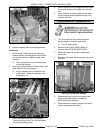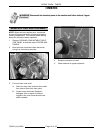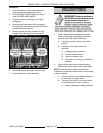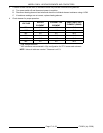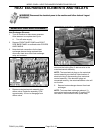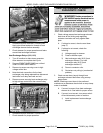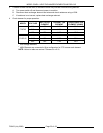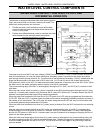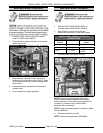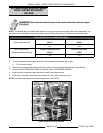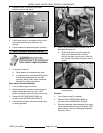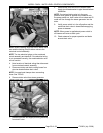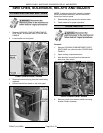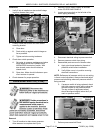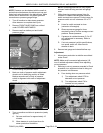
MODEL C24EA - WATER LEVEL CONTROL COMPONENTS
F35453 (July 2008)Page 21 of 68
WATER LEVEL CONTROL COMPONENTS
WATER LEVEL CONTROL - LOW LEVEL CUT-OFF AND
DIFFERENTIAL OPERATION
The steamer is equipped with three water level sensing probes
(high, low and low level cut-off) and a water level control. The
water level control performs two functions:
1. Provide low level cut-off protection to shut off the heat
source in case the water level drops below the low level
cut-off (LLCO) probe.
2. Perform as a differential level control to maintain the water
level between the low and high water level probes.
The water level control (WLC) has input voltage (120VAC) across terminals 11 and 12 which powers the primary
side of the transformer. On one side of the transformer secondary, power is provided to the control by a series
path through chassis ground (terminal 10). The other side of the transformer secondary (12VAC) is attached to the
probe that directs power to the other side of WLC relay coils (LLCO and HL) and to the inverse latching relay
(ILR) electronic circuit on the WLC. As water enters the steam generator, it becomes part of the WLC circuit. When
the water level in the steam generator reaches a probe, that circuit is completed.
The inverse latching relay of the WLC is de-energized, leaving the ILR-1 (N.O.) and ILR-2 (N.C.) contacts in their
shelf state.
When the main power switch is turned on, power is supplied to the WLC which energizes the high level (HL) relay,
closes HL-1 normally open contacts, and illuminates the HL relay LED. With the HL-1 contacts closed, the slow fill
solenoid is energized and water begins filling the steam generator.
When the water level reaches the low level cut-off (LLCO) probe, the LLCO relay is energized and illuminates the
LLCO LED. With the LLCO-1 contacts closed, the heat source can be energized provided the auxiliary control(s) in
the heating circuit are satisfied. The LLCO relay will remain energized and its LED will stay lit until the water level
in the steam generator drops below the LLCO probe.
When the water level reaches the low level (LL) probe, power to terminal 2 on the WLC is present but no switching
occurs.
After the water level reaches the high level (HL) probe, the inverse latching relay of the WLC is energized and
locked through the low level probe (LL) and ILR-1 contacts. With ILR-2 contacts open, HL relay is de-energized
and the HL LED goes out. With the HL-1 contacts open, the slow fill solenoid is de-energized, stopping the flow of
water into the steam generator.
When the water level drops below the low level (LL) probe, power is removed from the inverse latching relay, the
HL relay energizes through ILR-2 and HL contacts change state. The slow fill solenoid is energized through HL-1
to refill the steam generator and the HL LED is lit. The HL relay and LED will toggle on and off during a cooking
cycle as needed.



